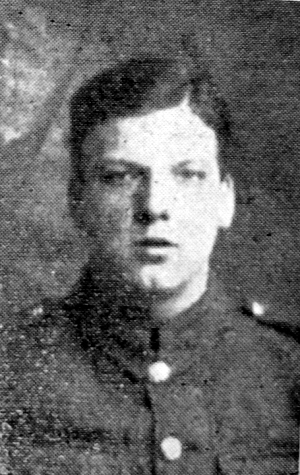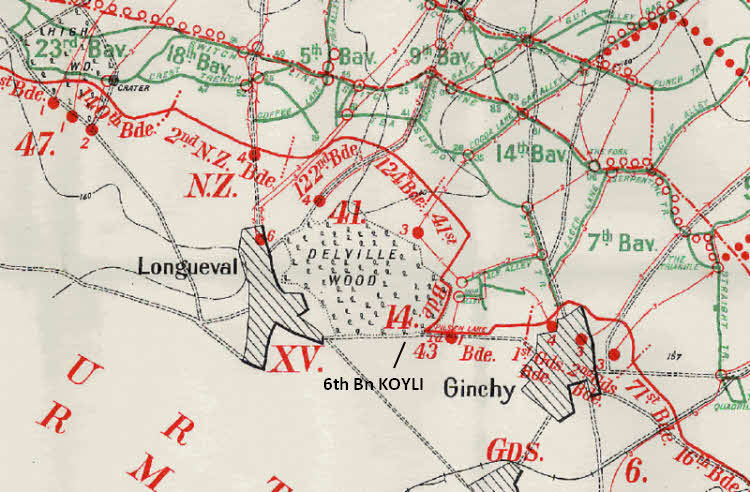
11248, King’s Own Yorkshire Light Infantry, 6th Battalion
John Pickles was born at Barugh Green, near Barnsley, in Summer 1896, the third child and only surviving son of Thornhill miner George Henry Pickles and his wife Bertha (nee Rothery) who married in early 1894. The couple had seven children but sadly three had died before April 1911.
In 1901, the couple had moved with their children, including John, to live and work at the Durham coalfield, but returned to Yorkshire by 1903. By 1911 George Henry and Bertha Pickles had moved from Barugh to Ossett, where they set up home at Vicar Lane with their four children aged between 8 years and 16 years of age. John was 14 years old and working as a hurrier in a coal mine.
John Pickles’ army service record has not survived, but it is known that he enlisted at Dewsbury, and joined the 6th Battalion of the King’s Own Yorkshire Light Infantry with service number 11248. He embarked for France on the 15th January 1915, even though at 18 years of age he was too young to do so.
The 6th (Service) Battalion, Kings Own Yorkshire Light Infantry was raised at Pontefract on the 12th of August 1914 as part of Kitchener’s First New Army and joined 43rd Brigade in 14th (Light) Division. They trained at Woking, moving to Witley in November 1914 for the winter, then moving to Aldershot in February 1915 for final training. They proceeded to France on the 21st of May 1915 landing at Boulogne. They fought in the The Action of Hooge, being the first division to be attacked by flamethrowers. They were in action in The Second Attack on Bellewaarde. In 1916 they were on the Somme seeing action in The Battle of Delville Wood and The Battle of Flers-Courcelette. In 1917 they fought in The German retreat to the Hindenburg Line, The First and Third Battle of the Scarpe at Arras, The Battle of Langemark and The First and Second Battle of Passchendaele. On the 19th of February 1918 the 6th KOYLI were disbanded in France as the army was reorganised.
Private John Pickles was killed in action on the 15th September 1916 whilst serving with the 6th (Service) Battalion of KOYLI at the the Battle of Flers-Courcelette, which took place between the 15th and 22nd September 1916. The battle was the third main phase of the Battle of the Somme. It is best known as the first tank battle in history, as it featured forty nine Mk I tanks (although not all of the tanks made it into battle).
“The 14th Division had to begin the day early, to clear the Germans out of a pocket east of Delville Wood, where they still held on to a forward position. This attack was carried out by two companies (W and X) of the 6th Battalion, King’s Own Yorkshire Light Infantry (KOYLI) supported by three tanks and they were ordered to expel the Germans prior to the main attack. Only one tank (D1) was operational and it advanced from Pilsen Lane followed by the KOYLI’s bombers. The infantry attack went in at 5.20 a.m. with tank D1 passing through the waiting infantry and crossing No Man’s Land, towards the German positions. As it reached the edge of Delville Wood, where it joined Hop Alley, it fired its 6lb guns into the wood. It then turned east, driving parallel to the Hop Alley trench; two infantry companies from the 6th Battalion KOYLI emerged from the wood and followed D1 to join in the attack. D1 then turned north at the junction with Beer Trench and followed Ale Alley, clearing the remaining German defenders and firing at the enemy as they fled to the north east. D1 advanced too quickly to the north, however, and strayed into the British creeping barrage, where a shell put the tank out of action! The infantry from the 6th Battalion KOYLI came under machine gun fire from their flank after crossing Ale Alley. Every single one of the KOYLI officers was lost, but what remained of the two companies under their NCOs turned back and with bomb and bayonet, dealt with their attackers. They later advanced and then took part in the main offensive.” 1
Despite the view of many authors who have written about Flers-Courcelette, who consider it as being a battle with relatively few casualties in view of the gains that had been achieved. Thousands of men on both sides had been killed, or wounded; many had simply ‘vanished’, blown to pieces in an instant by shellfire.
The “Ossett Observer” 2 had this obituary for John Pickles:
“Died With His Face To The Enemy – Ossett Soldier’s Fate – Three of four weeks ago we recorded that no news had been heard for some time of Private John Pickles, of the King’s Own Yorkshire Light Infantry, whose parents, Mr. and Mrs. George Henry Pickles, reside at Prospect-road, Ossett. Enquiries have this week resulted in a letter from being received from his platoon officer, stating that coming out of action, on September 15th, the soldier was missing at the roll call. The officer added that he made enquiries from comrades, two of whom who said that they had seen him fall wounded, but knew nothing further of him.
In a postscript to the letter the writer adds that, after penning the foregoing, intimation had been received from base that Private Pickles was killed in action on September 15th. The writer concludes: ‘You have the deepest sympathy of myself and the men of the platoon to which he belonged. It will be a consolation to you to know that he died with his face to the enemy, like a true soldier and hero.’
Private Pickles who used to work at Old Roundwood Collieries, where his father is employed, enlisted within a few days of his eighteenth birthday, just over two years ago. At the time the family resided in Bridle-lane, Gawthorpe. In the first battle of Ypres his right eye was damaged with lyddite, and as he also suffered frost in the feet, he was invalided for some time. The sight of his right eye being afterward defective, he is stated to have fired his rifle from the left shoulder.
Private Edgar Pickles, of the K.O.Y.L.I., who used to live in Victoria-street, South Ossett, and was killed at the front in July last, was an uncle of the deceased; Private Joseph Peace, of the North Staffordshire Regiment , whose home was at Horbury Bridge, and who, after serving eighteen years in the army, volunteered at the outbreak of war and died in Hastings, following a route march, was another uncle; and a third uncle is Private Arthur Pickles, of the Northumberland Fusiliers, formerly of South Ossett, who has served in the Near East and is now in France.”

Above: Map showing the position of the 6th Battalion, KOYLI on the 15th September 1916 at Delville Wood, the scene of bitter fighting during the Battle of Flers-Courcelette where Private John Pickles was killed in action.
Private John Pickles, aged 24 years, son of Mr. and Mrs. George Henry Pickles, of Prospect Rd., Ossett, died on the 15th September 1916. He is buried at grave reference XIII. R. 4. at the Guards Cemetery, Lesboeufs, 3 Somme France. Lesboeufs is a village 16 kilometres north-east of Albert.
Lesboeufs was attacked by the Guards Division on 15 September 1916 and captured by them on the 25th. It was lost on 24 March 1918 during the great German offensive, after a stubborn resistance by part of the 63rd Bn. Machine Gun Corps, and recaptured on 29 August by the 10th Bn. South Wales Borderers.
At the time of the Armistice, the cemetery consisted of only 40 graves (now Plot I), mainly those of officers and men of the 2nd Grenadier Guards who died on 25 September 1916, but it was very greatly increased when graves were brought in from the battlefields and small cemeteries round Lesboeufs.
There are now 3,136 casualties of the First World War buried or commemorated in this cemetery. 1,643 of the burials are unidentified but there are special memorials to 83 soldiers known or believed to be buried among them. Other special memorials record the names of five casualties buried in Ginchy A.D.S. Cemetery, whose graves were destroyed by shell fire, and three officers of the 2nd Bn. Coldstream Guards, killed in action on 26 September 1916 and known to have been buried together by the roadside near Lesboeufs, whose grave could not later be located.
The more considerable burial grounds concentrated into this cemetery were the following:
Flers Dressing Station Cemetery, Ginchy, between Delville Wood and Flers, containing the graves of 33 soldiers from Australia and eight from the United Kingdom who fell in September, 1916-March, 1917.
Flers Road Cemetery, Flers, on the Flers-Longueval road, containing the graves of 17 soldiers from the United Kingdom, three from New Zealand and one from Australia, who fell in October, 1916.
Ginchy A.D.S. Cemetery, on the North side of Ginchy village. This was a Field Ambulance cemetery, used from November, 1916 to March, 1917, and containing the graves of 77 soldiers from the United Kingdom and one from Australia.
Ginchy R.F.A. Cemetery, between Ginchy and Flers, containing the graves of 16 Artillerymen from the United Kingdom and five from Australia who fell in October, 1916-February, 1917.
Guards’ Burial Ground, Ginchy, on the East side of the village, containing the graves of 21 officers and men of the Guards Division who fell on the 15th September, 1916.
Needle Dump Cemetery, Lesboeufs, on the road to Flers, containing the graves of 23 soldiers from Australia and four from the United Kingdom who fell in October, 1916-March, 1917.
Needle Dump South Cemetery, Lesboeufs, about 50 yards South of Needle Dump Cemetery, containing the graves of 14 soldiers from Australia and nine from the United Kingdom who fell in October, 1916-March, 1917.
Switch Trench Cemetery, Flers, a little East of the Flers-Longueval road, containing 110 (mainly Australian) graves of 1916-17. On the site of another part of Switch Trench, further West, the New Zealand Government have erected one of their two Battlefield Memorials in France.
Windmill Trench Cemetery, Lesboeufs, on the road leading North from Lesboeufs. It was used from September, 1916 to March, 1917, and it contained the graves of 27 soldiers from the United Kingdom and 16 from Australia.
CWGC heastone photograph courtesy of Mark Smith
References:
1. The Battle of Flers-Courcelette
1. “Ossett Observer”, 5th January 1917